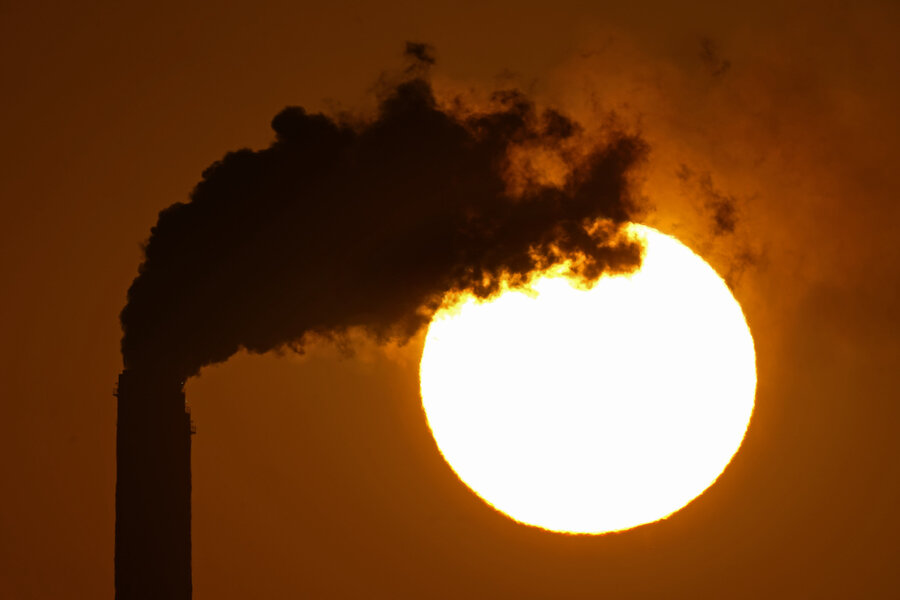US soot pollution has been dropping. An EPA rule will drop it further.
Loading...
| Washington
The Biden administration is setting tougher standards for soot pollution to reduce fine particle matter from tailpipes, smokestacks, and other industrial sources.
Environmental and public health groups hailed the new Environmental Protection Agency rule finalized Feb. 7 as a major step in improving the health of Americans, including future generations. Industry groups warned it could lead to loss of manufacturing jobs and even shut down power plants or refineries.
EPA Administrator Michael Regan said the rule would have $46 billion in net health benefits by 2032, including prevention of asthma attacks and premature deaths. He said the rule will especially benefit children, older adults, and those who have been diagnosed with heart and lung conditions, as well as people in low-income and minority communities adversely affected by decades of industrial pollution.
The rule “really does represent what the Biden-Harris administration is all about, which is understanding that healthy people equal a healthy economy,’’ he told reporters Feb. 6. “We do not have to sacrifice people to have a prosperous and booming economy.’’
The rule sets maximum levels of nine micrograms of fine particle pollution per cubic meter of air, down from 12 micrograms established a decade ago under the Obama administration.
The rule sets an air quality level that states and counties must achieve in the coming years to reduce pollution from power plants, vehicles, industrial sites, and wildfires. The rule comes as Democratic President Joe Biden seeks reelection, and some Democrats have warned that a tough soot standard could harm his chances in key industrial states such as Pennsylvania, Michigan, and Wisconsin.
Administration officials brushed aside those concerns, saying the industry has used technical improvements to meet previous soot standards and will be able to adapt to meet the new standard as well. Soot pollution has declined sharply in the past two decades, even as the United States gross domestic product has increased by more than 50%, Mr. Regan said.
“So we’ve heard this argument before, but the facts are well-established that these standards really will increase the quality of life for so many people, especially those who are disproportionately impacted,’’ he said.
Manish Bapna, president and CEO of the Natural Resources Defense Council, an environmental group, said the EPA was “putting public health first by requiring polluters to cut soot from the air we all breathe.’’
Ben Jealous, executive director of the Sierra Club, said that opponents’ “resistance is a stark reminder that the fight for clean air and a healthier future is far from over.’’
Industry groups and Republican officials said before the rule-making that a limit of nine micrograms per cubic meter could sharply increase the number of U.S. counties in violation of the soot standard. Companies in those places would have difficulty obtaining permits to build or expand industrial plants.
Significantly lowering the standard for soot emissions “would threaten or prevent modernization projects and other major improvements to paper mills,’’ the American Forest and Paper Association said in a statement.
“As our industry modernizes paper mills, we’re improving air quality,’’ including reductions in particulate matter, the group said.
The paper lobby and other industry groups said in a letter to the White House that a lower soot standard could force companies to locate new facilities in foreign countries with weaker air-quality standards, thereby undermining the Biden administration’s economic and environmental goals.
“We urge you to ensure EPA maintains the existing fine particulate matter standards to ensure both continued environmental protection and economic growth,” 71 groups, led by the National Association of Manufacturers, said in an Oct. 31 letter to White House chief of staff Jeffrey Zients.
The standard for particle pollution, more commonly known as soot, was set in late 2012 under Democratic President Barack Obama and left unchanged by Republican President Donald Trump, who overrode a scientific recommendation for a lower standard in his final days in office.
The new EPA rule would require states, counties, and tribal governments to meet a stricter air quality standard for fine particulate matter up to 2.5 microns in diameter – far smaller than the diameter of a human hair.
The standard would not force polluters to shut down, but the EPA and state regulators could use it as the basis for other rules that target pollution from specific sources such as diesel-fueled trucks, refineries, and power plants.
A 2023 report by the American Lung Association found that nearly 64 million Americans live in counties that experience unhealthy daily spikes in soot pollution and nearly 19 million live in counties that exceed annual limits for soot pollution. Most of those counties were in 11 Western states, the report said. People of color were 61% more likely than white people to live in a county with unhealthy air quality, the report said.
Bakersfield, California, displaced Fresno, California, as the metropolitan area with the worst short-term particle pollution, the report found. Bakersfield tied with Visalia in California’s San Joaquin Valley as the most polluted city for year-round particle pollution.
Wildfires in the western U.S. were a major contributing factor to increased levels of particle pollution, the report said. Six of the 10 cities with the most soot pollution were in California, and two more were in the West: Medford, Oregon, and greater Phoenix.
This story was reported by The Associated Press.







